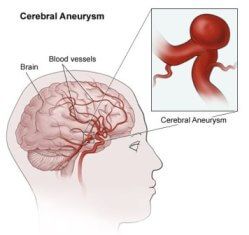How to detect a Brain Aneurysm
It is a bulge or ballooning in a blood vessel in the brain, which often looks like a berry hanging on a stem.
A brain aneurysm can leak or rupture, causing bleeding into the brain (hemorrhagic stroke). Most often a ruptured brain aneurysm occurs in the space between the brain and the thin tissues covering the brain and we call it a subarachnoid hemorrhagic stroke.

What are the effects of a brain aneurysm?
A brain aneurysm may not cause any symptoms unless it ruptures, but in some cases, it can show the following signs:
- Visual disturbances
- Pain above or around the eye
- Numbness or weakness in the face
- Difficulty speaking
- Headaches
- Balance problems
- Difficulty concentrating
- Problems with short-term memory
What causes brain aneurysms?
It’s not clear why a brain aneurysm forms. Researchers and neurosurgeons believe these factors irritate and weaken blood vessels:
- Smoking.
- Blood infection.
- High blood pressure (hypertension).
- Amphetamine and cocaine use.
- Traumatic brain injury (often caused by car crashes).
- Atherosclerosis (fatty buildup on blood-vessel walls).
How is a brain aneurysm diagnosed?

Your neurosurgeon will order a few imaging tests. These tests show the size, shape and location of brain aneurysms:
- MRI (magnetic resonance imaging).
- CT (computed tomography).
- Diagnostic cerebral angiogram
- MRA (magnetic resonance angiography).
- CTA (computed tomography angiography).
How are brain aneurysms treated?

Surgery and/or endovascular therapy are the treatment for brain aneurysms, whether they are ruptured or unruptured.
A neurosurgeon treats brain aneurysms using a variety of methods, or a combination of methods, depending upon the type of aneurysm and the individual patient, which may include:
- Clipping
- Other techniques:
- Artery occlusion and bypass
- Flow diversion with stents
- Tubular retractor system
- Observation
Read also:
